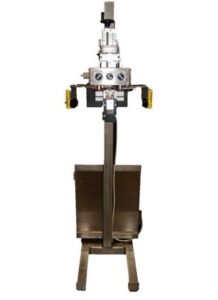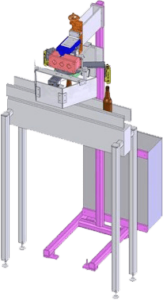 Many installed vision systems get disconnected or fail to produce results over time because:
Many installed vision systems get disconnected or fail to produce results over time because:
- They get moved or “tweaked” out of alignment
- Reject rates, alarms or poor results rise over time
- Line operators cannot easily program new product configurations into the system
- Inspection programming is not robust enough for all in-plant scenarios
How can you prevent or fix these issues?
Vision systems are useless if they don’t reliably perform the inspection(s) you need.
Troubleshooting an existing system
Reliable vision inspections require several things to happen nearly simultaneously. The object to be inspected has to move across the field of view of the camera, the camera must know the object is there and perform the inspection, and the image the camera captures must be high quality enough to perform the inspection.
To troubleshoot your vision system, you will need to start by investigating which one (or several) of these things are not happening.
Step 1: Investigate your vision systems alignment – A common reason why vision systems stop working is because they get “tweaked” by one line operator, then the next. Or accidentally bumped into by maintenance. Or completely moved and put back incorrectly.
Though it may seem rudimentary, start with a vision system inspection. Does the camera appear to be pointing at the correct spot to accurately perform the inspection? Review the most recent images, and compare them to when the system was working. Does the alignment look the same?
Step 2: Deep dive into your image quality
Even if the field of view for your images looks the same, inspecting recent captures may immediately alert you to other problems. Inspections are only as good as the image they can produce. High-quality images require good contrast and resolution, which in turn require good lighting, lens placement, and minimal glare.
This also where a comparison image is useful. Has dirt obscured the lens of the camera and led to a poorer quality image? Has a light burned out? Are the filter and lens misaligned changing the image contrast or creating a glare issue? These should all be obvious in the images being captured by the camera.
Step 3: If you do see a difference in the images determine if it is the camera or the lens
Problems with the camera will affect the entire image: contrast (too light or too dark) that is evenly, over, or underexposed across the entire image, consistent noise across the image, strange hues or white balance issues for example.
Lens issues tend to be more localized. Dark corners, bright spots, varying focuses across a series of images, these are all examples of lens issues. Lenses rarely fail, but when they do it is usually because they are misaligned (from vibrations over time for example) or damaged. It may require a vision expert to properly diagnose a lens issue.
Step 4: Other potential physical issues to consider
Sometimes, vision systems aren’t failing at all. A common mistake is to assume that the vision system will work perfectly fine on the items it was trained with, even when they undergo significant packaging, label or color changes. Inspecting a blue matte bottle is very different than inspecting a clear glossy bottle, even if the shape didn’t change.
Examine the images the vision system is producing. Can you see the defect in the images? If you can’t the camera cannot. Is the added glare, lack of contrast, etc. due to the reasons above or did something about the objects being inspected change? Did the distance from inspection change because packages got larger or smaller?
OR – did something in the environment change? Does a ray of light cross the lens every afternoon at 4pm and cause the inspection to fail for an hour? Did dust start covering half the lens and making only half of every object inspectable?
Step 5: When can I blame it on the programming?
Very rarely does the programming on a vision system change, but it can happen. If the images appear to be the same you can start investigating software.
More likely, is that an operator changed a software parameter – for example relaxing pass fail criteria. Even one percentage point difference in stringency can drastically alter how the vision system rejects product. The other likely culprit is a software update. You should be able to roll back any recent updates and see if the system starts working properly again. If you roll the software back and continue to get an error, it is more likely a hardware issue.
Step 6: Failing to capture images or reject products
The last set of possibilities you have is that the controls or sensors are failing. If you go to review images and find no images are being capture at all, then either the sensor that triggers the camera or the signal from the sensor to the camera is not working.
Alternately, if the camera is capturing images and properly processing fails but products are not being rejected off the line, there is a control or sensing issue occurring between the camera and the rejector. Do a test run with damaged product and verify the camera correctly rejects the parts. If it does and they are not rejected off the line, that is your issue.
Step 7: Hail Mary
If you have run through this list and still cannot identify and correct the issue, it might be time to have a vision expert come out and evaluate the system. Inconsistent results, measurement errors, or product skips may indicate that the vision system you have is not actually appropriate for the inspection you are trying to perform. The camera may not be able to perform the inspection fast enough, or the lighting setup may not be creating a high enough contrast image. This is where a vision expert can advise.
Preventing vision failure to begin with
If instead of trying to figure out why your vision system has turned into a useless pile of line attachments and you just want it to work right, get a vision system designed for your line by experts.
EPIC vision systems that deliver value to you for many years. Our product specific testing, programming experience, and high-end stand fabrication ensure:
- Highly accurate inspections tailored to your specific products. We routinely deliver systems where customers require accuracy rates in excess of 99.9%
- Systems stay in alignment and thrive on your plant floor.
- Our stand-alone welded vision stands ensure accurate inspections by:
- Locking cameras, lighting, and filters at the correct angles & distance
- Protecting the inspection equipment from vibration
- Prevent misalignment from operators or maintenance
- Improve lighting and protecting from dust
- No “tweaking” or manual intervention is required or possible
- A seamless experience for line operators by integrating with regular line controls. When a product SKU is changed, our vision system automatically adjusts to inspect the correct profile.
- A flexible and lean manufacturing environment by: Maintaining or even reduce the time it takes to perform product changeover
- Making it easy for you to add new products for inspection, troubleshoot issues, and access inspection information on your HMI
To get help troubleshooting your existing system or learn more about an EPIC vision solution, contact us: (314) 714-1580.
——————————
Some material sourced from: https://www.qualitymag.com/articles/85482-troubleshooting-vision-systems
